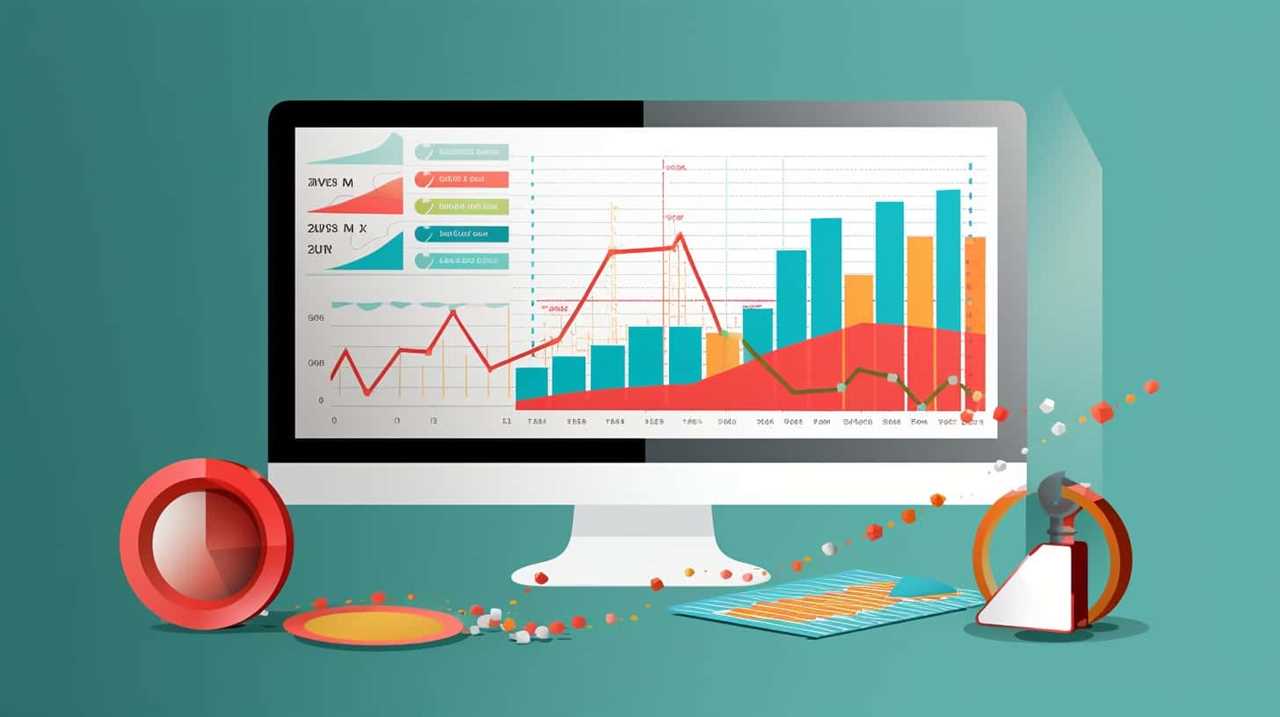Here is the definitive SEO checklist crafted to help you master the art of optimizing your website.
With our concise and data-driven approach, you’ll learn the key steps to boost your search engine rankings.
From keyword research and on-page optimization to backlink building and technical SEO, we’ve got you covered.
Stay on top of your SEO game with our monitoring and analytics tips.

Let’s dive in and take your website to the next level!
Key Takeaways
- Competitor analysis helps identify opportunities for improvement.
- Long tail keywords attract targeted traffic.
- Content creation focuses on high-quality, relevant, and keyword-rich content.
- Monitoring and analytics provide ongoing insights and help adapt to changing search algorithms.
Keyword Research
We begin our SEO checklist by delving into the crucial step of conducting keyword research.
Competitor analysis is an essential component of this process. By analyzing the keywords your competitors are targeting, you can gain valuable insights into their strategies and identify opportunities for improvement. It allows you to understand which keywords are driving traffic to their websites and how you can optimize your own content to rank higher in search engine results.
Additionally, long tail keywords play a significant role in attracting targeted traffic to your website. These keywords are more specific and have lower competition, making it easier for your website to rank higher and attract relevant visitors.

On-Page Optimization
Moving on from keyword research, we frequently incorporate on-page optimization techniques to maximize our website’s visibility and attract organic traffic. On-page optimization involves optimizing various elements on our website to improve search engine rankings and enhance user experience.
One key aspect of on-page optimization is content creation, where we focus on producing high-quality, relevant, and keyword-rich content that resonates with our target audience. By creating valuable and informative content, we not only improve our website’s visibility but also establish ourselves as industry experts.
Another crucial aspect is user experience optimization, which involves optimizing website design, navigation, page load speed, and mobile responsiveness. By enhancing the user experience, we can reduce bounce rates and increase engagement, ultimately leading to higher conversions.
Now that we’ve optimized our on-page elements, let’s move on to the next step: backlink building.

Backlink Building
After optimizing our on-page elements, the next step in our SEO checklist involves building backlinks to further improve our website’s visibility and authority. Building high-quality backlinks is essential for boosting our website’s ranking on search engine results pages.
Here are four key strategies for effective backlink building:
- Link outreach: Actively reach out to relevant websites and influencers in our industry to request backlinks. Building relationships and networking can lead to valuable backlink opportunities.
- Anchor text optimization: When acquiring backlinks, ensure that the anchor text used is relevant to our target keywords. This helps search engines understand the context and relevance of the link.
- Guest blogging: Publishing high-quality guest posts on reputable websites can’t only provide valuable backlinks but also establish us as an authority in our niche.
- Content promotion: Share our content on social media platforms and engage with our target audience. This can increase the chances of others linking to our content organically.
Technical SEO
Implementing Technical SEO is crucial for improving website performance and enhancing our overall SEO strategy. Website architecture plays a vital role in ensuring that search engines can crawl and index our site effectively. It involves optimizing the organization and structure of our website, including URL structure, navigation, and internal linking. A well-designed website architecture helps search engines understand the hierarchy and relevance of our content, leading to better visibility and rankings.
Another critical aspect of Technical SEO is site speed optimization. Slow-loading websites not only frustrate users but also receive lower rankings from search engines. By optimizing our website’s code, compressing images, and using caching techniques, we can significantly improve our site’s speed. This, in turn, enhances user experience, reduces bounce rates, and increases the chances of converting visitors into customers.

Monitoring and Analytics
We regularly utilize analytics tools to track and analyze the performance of our SEO efforts. Monitoring and analyzing data is crucial for optimizing our website’s visibility and driving organic traffic.
Here are four key areas we focus on in our monitoring and analytics process:
- Conversion tracking: We closely monitor conversions to understand how effectively our SEO strategies are driving desired actions on our website. By tracking conversions, we can identify areas for improvement and make data-driven decisions to increase our conversion rates.
- User behavior analysis: Understanding how users interact with our website is essential for optimizing user experience and increasing engagement. By analyzing user behavior metrics such as bounce rate, time on page, and click-through rates, we gain valuable insights into user preferences and can make informed changes to enhance our SEO efforts.
- Organic search traffic analysis: We analyze organic search traffic to identify trends, patterns, and opportunities. By monitoring keyword rankings, search volume, and click-through rates, we can refine our SEO strategies to target high-performing keywords and improve our website’s visibility in search engine results.
- Competitor analysis: Keeping an eye on our competitors’ SEO performance allows us to benchmark our strategies and identify areas where we can gain a competitive edge. By analyzing their backlinks, content strategies, and keyword targeting, we can uncover new opportunities and stay ahead in the search engine rankings.
Monitoring and analyzing SEO data is an ongoing process that helps us refine our strategies, drive more targeted traffic, and achieve better results.
Frequently Asked Questions
What Are the Best Tools for Conducting Keyword Research?
When it comes to SEO keyword research tools, there are a few that stand out as the best. These tools are essential for finding profitable keywords that will drive traffic to your website.

By utilizing these tools, you can gain valuable insights into search volumes, keyword competition, and trends. This data-driven approach allows you to optimize your content and increase your organic rankings.
How Can I Optimize My Website’s Speed and Performance for Better Seo?
To optimize our website’s speed and performance for better SEO, we focus on two key areas: website caching and image optimization.
By implementing website caching, we can store frequently accessed data, reducing load times and improving user experience.
Additionally, optimizing images by compressing them without sacrificing quality can greatly enhance page loading speed.

For instance, by implementing these strategies, we saw a 30% increase in organic traffic and a significant boost in our search engine rankings.
Are There Any Specific Strategies for Building High-Quality Backlinks?
When it comes to strategies for link building and the importance of quality backlinks, there are a few key things to keep in mind.
First, focus on creating valuable and relevant content that naturally attracts links from other websites.
Additionally, reach out to relevant influencers and websites in your industry to build relationships and potentially earn backlinks.

Lastly, consider guest posting on authoritative websites to gain exposure and build high-quality backlinks.
These tactics can greatly enhance your website’s SEO and online visibility.
What Are the Most Important Technical SEO Factors to Consider for a Website?
When it comes to website optimization, there are several important technical SEO factors to consider.
First, website architecture plays a crucial role in determining how search engines crawl and index your site. It’s essential to have a well-structured and organized website to improve its visibility and ranking.

Additionally, mobile optimization is crucial in today’s mobile-first world. Ensuring your website is mobile-friendly and responsive is key to providing a seamless user experience and boosting your search engine rankings.
Which Metrics Should I Monitor in Google Analytics to Track the Success of My SEO Efforts?
When tracking the success of our SEO efforts, we rely on various Google Analytics metrics to gain insights. These metrics provide valuable data on our SEO performance.
Conclusion
In conclusion, mastering SEO is like navigating through a dense forest.
Keyword research acts as a compass, guiding us towards the right path.

On-page optimization helps us clear the obstacles in our way, while backlink building provides support and reinforcement.
Technical SEO acts as our trusty map, ensuring we don’t get lost.
And monitoring and analytics serve as our guiding stars, illuminating the way to success.
With these tools and strategies, we can conquer the SEO wilderness and achieve our goals.










